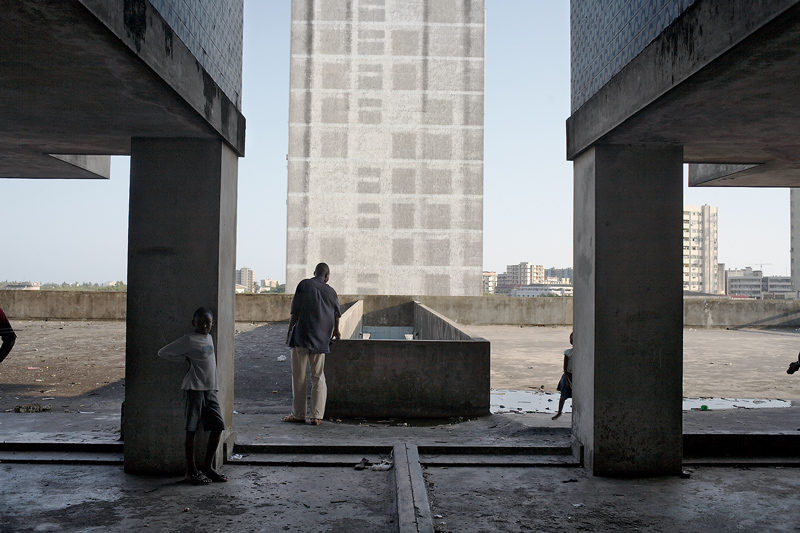[Winter 2012]
Guy Tillim
“Avenue Patrice Lumumba”
The Design Exchange, Toronto
20 April to 14 June 2011
Guy Tillim’s sizable exhibition (initially organized by the Museum of Contemporary Photo at Columbia College in Chicago) at the Design Exchange was a provocative inclusion in 2011’s Scotiabank contact Festival. The title of the exhibition evokes the spirit of Patrice Lumumba, a staunch supporter of African nationalism and the first elected prime minister of the Congo after it gained independence from Belgium in June 1960. Lamumba’s term in office was cut short ten weeks later, when he was overthrown and imprisoned; subsequently, he was murdered in a coup initiated by Mobutu Sese Seko (whose authoritarian rule of the Democratic Republic of the Congo lasted until the early 1990s), reputedly in collaboration with Belgian and American secret forces. Given Lumumba’s commitment to full African autonomy – rather than the indirect control that the colonial powers wanted to retain – his presence remains on streets named in his honour in many cities across the continent and the globe.
The fifty-five photographs in the exhibition, taken in 2007 and 2008, depict the architecture built concurrently with the end of colonial rule across Africa – specifically, in Angola, Benin, Ghana, Madagascar, Mozambique, and the DRC – and, ironically, in variations on the high modernist style imported from the West. (Perhaps not unintentionally, the imposing presence of the gallery itself, housed in the sleek steel-and-glass tower of Mies van der Rohe’s Toronto Dominion Centre, affirmed the political [read: spatial] and psychological influence that such buildings hold. The gallery is a formidable space, and its large window overlooking Bay Street necessitated the double hanging of a large number of the works, which made the upper tier difficult to view.) Within the frame of Tillim’s camera, these luxury hotels, sports clubs, universities, and high-rises, built in the wake of a promise that, more than fifty years later, remains unfulfilled, now sit in disuse and disrepair.
At first glance, Tillim’s photographs seem to fetishize surface or form, somewhat reminiscent of the weathered patinas that Robert Polidori seeks in his work. If we dig deeper, however, we find that his images are more humane, juxtaposing the leftover monuments of colonial rule with a sense of quiet theatre. Rather than pointing his camera squarely at his subjects, he angles his lens obliquely amid the modernist ruins to observe the spaces left between their walls. The sense of emptiness is heightened in his wide framing of these public and private urban spaces – places in which he seems to find not despair but quiet pauses.
Countering the Western influence embedded in high modernism’s International style, Tillim’s photographs document how it has been impossible for these buildings to endure unstable governments and tropical climes. In several images, cracked stucco and blackened, mouldy concrete grace the façade of the former Grande Hotel in Beira, Mozambique. Abandoned by its rich clientele, the hotel has taken on permanent residents, as indicated by the line of brightly coloured laundry hung out to dry on its large semi-circular patio. Tillim’s lens seeks out traces of human intervention among his static subjects, from graffiti adorning the walls of an apartment block in Maputo, Mozambique, to more functional alterations that tweak and subsequently defile the pristine aesthetic of the buildings. In an apartment block in Luanda, Angola, plastic conduits snake electrical wiring up through a staircase with a wrought-iron banister; elsewhere in the building, haphazard, triangle-shaped crenellations trace the outer edge of a metal gate leading to a balcony. These interventions mark the presence of the building’s current inhabitants and are, in a sense, a type of passive resistance that repurposes the existing structure.
While Lumumba is invoked in name, the symbolic representations of some of his peers caught with Tillim’s camera affix their current influence – such as the monumental statues by Ghana’s Kwame Nkrumah (which are installed at the national museum in Accra and which Tillim has depicted from behind), Angola’s Agostinho Neto (still wrapped in black plastic in the main square in Sumba), and large billboards of the DRC’s Laurent Desiré Kabila (turned on their side and tucked away in a seemingly abandoned courtyard in Likasi). Though the series is perhaps more understated than Tillim’s previous work – such as the charged images in his 2006 series Congo Democratic that depicted the circumstances surrounding the national elections in the country – the subtle decisions and inclusions shown here suggest that even the quietest streets in Africa are politicized.
Jen Hutton is an artist and writer currently based in Los Angeles, where she is working toward a MFA at the California Institute of the Arts.


